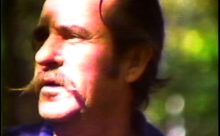Blaine Dunlap on this early use of portable video
Here are some tech details:
Hitachi 3030 single-tube camera http://www.labguysworld.com/Hitachi_FP-3030.htm
JVC CR-4400U 3/4" Umatic portable deck http://www.labguysworld.com/JVC_CR-4400.htm
Switar 10mm lens http://www.flickr.com/photos/39153031@N03/3607378989/
****
audio recorded double system with Nagra IV-2 (mono) http://www.retrothing.com/2006/01/modern_nagra_42.html
mostly with Sennheiser 415 mike
****
Off-line edited with two Sony 2850 3/4 Umatic machines http://wn.com/umatic
(using 3/4 'workdubs' of camera original rolls, with 'burned in time-code' to notate in and out frames of each cut.)
On-line editing- prep
20-minute camera original U-matic rolls (I called them 'rolls' since I was trained in film. They became 'reels' after a point) were all 'up-dubbed via a Sony 810 Time Base Corrector, while also resolving the Nagra tapes into the audio portion of the Quad tapes
(sync marks consisted of Ron Judkins, sound man, tapping on the mike three time: pop --- pop --- pop ---)
I would hold the pinch-roller of the Nagra, cued to the second POP, and miraculously, the Nagra reached speed by the THIRD POP, and played back the audio in sync...
(that is, until the 29.97 fps of the video got ahead of the 'dead sync' of the Nagra's 7.5ips (30 fps) --- when sync became too soft, I'd create an "off-set" of however many frames, and read that correction to the On Line Engineer)
...to 60-minute 'reels' of Quad tape (broadcast engineers always called them reels, since they were backgrounded in audio)
since time-code is essentially an 88-bit 'square wave' analog signal (in other words, it is an analog signal pretending to be digital) http://www.eecis.udel.edu/~mills/ntp/wwv_h_tc.jpg
This meant the time-code of the Quad edit 'play-back' reels (as opposed to the 'record reel') had to be matched against ALL the in and out numbers of the fine-cut of the off-line master
Whew!
The on-line room at GA ETV consisted of two playback machines, I forget the RCA model, but the record machine was an RCA - TR- 70 C
The final EE master was played back on the one GREAT Quad machine ever made, the Ampex AVR-1, to produce the PBS master of no electronic cuts.
If we found we needed to go back into the show to make changes, the entire damn thing went another generation, meaning at the end of the day you might have 4th generation for the first seven minutes, 3rd generation for the next seven minutes, and 2nd generation for the rest of the program. (first gen being CAM ORIG)
ps Ron Judkins, my SMU film-school classmate who helped with "Sometimes I Run" recorded "Raw Mash," then went over to L.A. to pitch in, worked his way to being the chosen location mixer of S. Spielberg, won Oscars for "Schindler's List," and "Jurassic Park"
